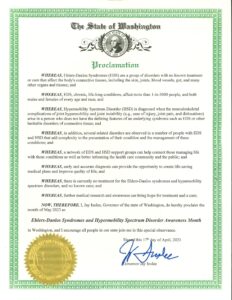Written by Carter Hemion
On April 17, 2023, Governor Inslee signed a ceremonial proclamation recognizing May as Ehlers-Danlos Syndromes and Hypermobility Spectrum Disorder Awareness month in Washington State. The International EDS and HSD Awareness Month is a time for the communities to create lasting positive change to save and improve patients’ and families’ lives.
Since 2006, the Ehlers-Danlos syndrome (EDS) and hypermobility spectrum disorder (HSD) communities have been honoring awareness month in May. The month recognizes and raises awareness for people living with the genetic connective tissue disorders in hopes of increasing early diagnosis and finding treatments.
Increased awareness, education, and research around EDS and HSD can significantly improve patients’ quality of life, help develop new treatment options, and foster greater support for patients living with EDS, HSD, and related conditions.
Creating more awareness can open doors to better understanding and supporting people with EDS and HSD and improve patients’ experiences in areas of life like interpersonal relationships, employment, education, healthcare, and more.
Now, with the additional healthcare barriers patients have faced throughout the COVID-19 pandemic and knowing some EDS and HSD patients are at a higher risk for complications from COVID-19 infection, it is more important than ever to continue increasing awareness and support for patients living with EDS and HSD.
About EDS and HSD
EDS is a group of genetic connective tissue disorders with varied causes and presentations. There are at least 13 subtypes identified so far, and not all genetic causes have been identified yet. The disorders affect collagen’s structures and functions or related proteins that make up the connective tissues found throughout the body. Common symptoms can include joint hypermobility, dislocations, and pain; differences in skin healing, bruising, texture, or stretchiness; organ fragility; and a variety of other multisystemic symptoms that vary by subtype and patient.
HSD is similarly characterized by symptomatic joint hypermobility and instability and tissue fragility in the absence of another connective tissue disorder like EDS. People with HSD may experience injuries more easily than their peers and have chronic pain as a result.
EDS and HSD have no routine screening or FDA-approved therapies. For EDS and HSD patients, early and accurate diagnosis can provide opportunities for life-saving medical plans and better quality of life. The disorders are often poorly understood among medical professionals and patients may go undiagnosed or misdiagnosed for many years.
Ways to Support EDS and HSD Families
- Learn about the conditions. Read patients’ stories on Patient Worthy, blogs, and social media to understand their experiences. Learn more through articles from experts on the conditions and posts from patient organizations.
- Participate in awareness month activities. Join EDS and HSD families internationally in raising awareness. You can share patients’ social media posts and stories, donate to patient organizations, start conversations about the conditions, and learn more about EDS and HSD.
- Donate to or fundraise for patient organizations. In the United States, organizations like Hyp-ACCESS and Ehlers-Danlos Society serve patient populations. In Washington state, groups like Eastside EDS advocate for awareness and education for patients and providers.
Join the Ehlers-Danlos Syndromes and Hypermobility Spectrum Disorder communities is raising awareness internationally this May and every month.







